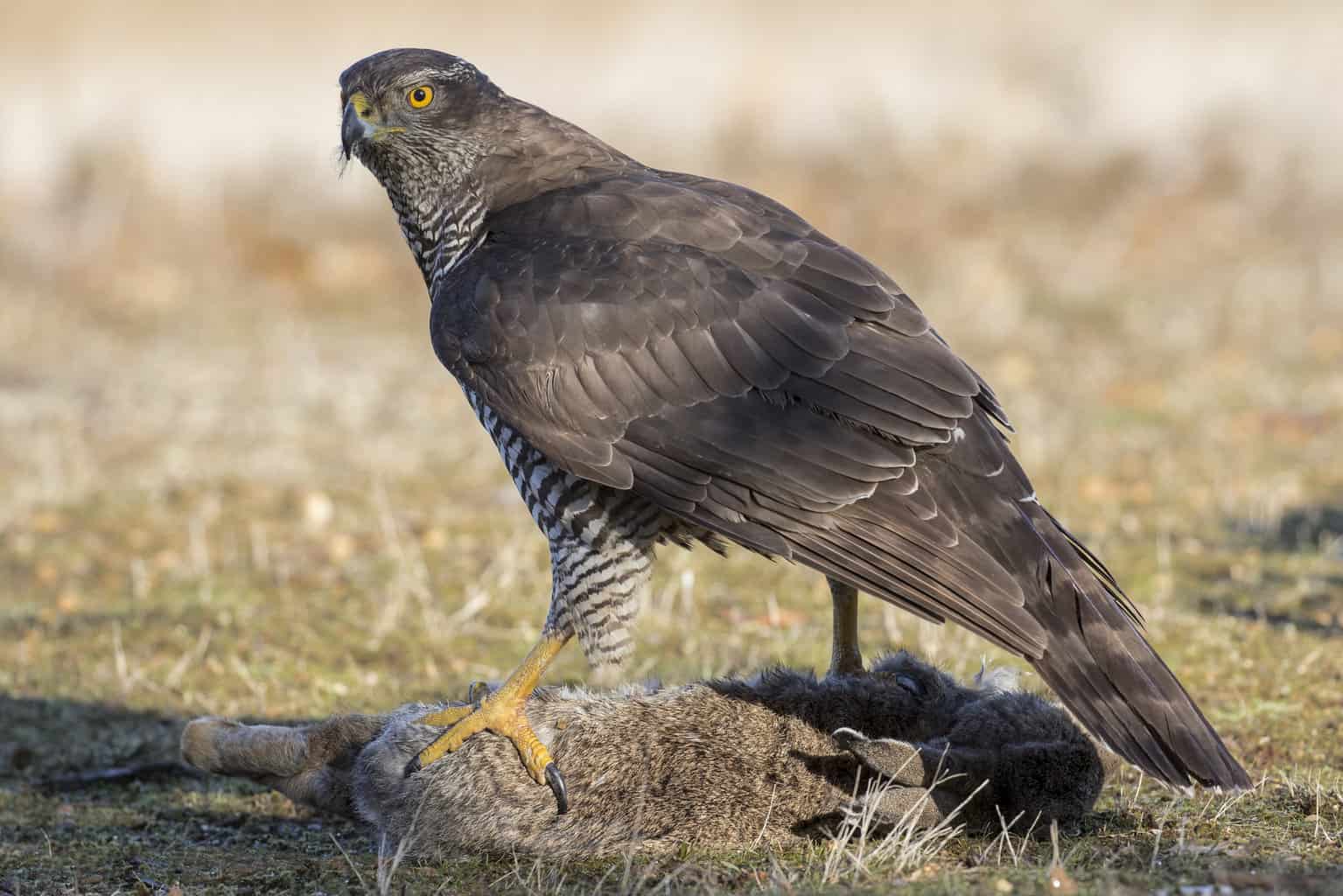Hawks comprise a family of birds within the Accipiter genus and another group of birds (called buzzards elsewhere) within the Buteo genus.
Understanding what these birds eat can be important – especially if you want to keep pets or smaller garden livestock safe from predation. It can also be an interesting in-road to learning more about these impressive birds.
Globally, there are over 200 hawk species. Of these, at least 17 types of hawks can be found in North America. Those that are most widespread across the United States and Canada are:
- Broad-winged hawk – Buteo platypterus
- Cooper’s hawk – Accipiter cooperii
- Ferruginous hawk – Buteo regalis
- Northern Goshawk – Accipiter gentilis
- Red-shouldered hawk – Buteo lineatus
- Red-tailed hawk – Buteo jamaicensis
- Rough-legged hawk – Buteo lagopus
- Sharp-shinned hawk – Accipiter striatus
- Swainson’s hawk – Buteo swainsoni
The Common Black-hawk, Harris’s hawk, Gray hawk, Short-tailed hawk, White-tailed hawk, and Zone-tailed hawk can be found in the southern states and Mexico.
The accipitrine hawks generally hunt birds as their primary prey. They are also called “hen-hawks” or “wood-hawks” because of their woodland habitat. Buteo hawks eat many small mammals, other creatures, and smaller birds.
But do any of these hawks eat rabbits? Do they pose a risk to rabbits on your property?
Do Hawks Eat Rabbits?
Indeed, many hawks will eat rabbits. Rabbits are prey for some species of hawk, and even those that do not regularly eat rabbits may still see them as potential prey if they seem like an easy target.
Which Hawks Eat Rabbits?
The Red-tailed hawk, Sharp-shinned hawk, Red-shouldered hawk, and Cooper’s hawk, in particular, are hawks that are known to prey on small animals in backyards. They can occasionally pose a risk to backyard chickens and can also be a problem for those keeping rabbits.
Red-tailed hawks are the most common hawk in the US, and since most of their diet is made up of mammals, they are perhaps more likely than the other species to eat wild rabbits and rabbits in your backyard.
Mammals make up the bulk of most Red-tailed hawk meals. Frequent victims include voles, mice, wood rats, snowshoe hares, jackrabbits, ground squirrels, and, yes, rabbits.
Hawks won’t know the difference between rabbits in the wild and pet or farmed rabbits on your property.
Can a Hawk Pick Up a Rabbit?

Larger hawks can pick up a rabbit. Smaller hawks, like a Cooper’s hawk, won’t be able to take an adult rabbit whole and carry it away. But, these and other smaller hawks could quite easily take a baby rabbit if one is unfortunately left undefended.
Larger hawks, like the Red-tailed hawk, are said to be able to lift up to five pounds. So they could easily carry most rabbits away.
What Other Predators Can Be a Danger to Rabbits in Your Yard?
Aside from larger mammals, several other birds besides hawks might also eat rabbits, including eagles and American kestrels. Though the kestrel is much smaller, it has been known to attack younger rabbits.
So, as well as creating a fox-proof enclosure, if you are keeping rabbits in your yard, you also need to make sure you create a space to keep rabbits safe from aerial attack.
How to Protect Rabbits from Hawks & Other Birds
The good news is that while rabbits are potentially in danger from hawks and other birds, you can make sure that your rabbits are protected from predation while still ensuring that these amazing birds are welcome in your area and are free to find other prey.
A rabbit hutch or accommodation space must have a sturdy roof that protects them from the elements and aerial attacks. Remember, hawks have powerful talons, so you must ensure that they or other predators won’t simply tear apart your structure.
Rabbits will thrive if they have an outside area that they can use, but, any outdoor area must be surrounded by strong metal mesh or wire. Make sure the mesh isn’t only present on the sides, but also below to stop them from digging out and escaping, and above, to protect them from predators attacking from the air.
Note that regular chicken wire won’t necessarily be strong enough to keep hawks out if they are determined to reach the ‘food’ within.
As long as your rabbits are safely contained, and there is no way for hawks to get to them, you can still create a wildlife-friendly garden and welcome any birds – hawks included – that visit.
Hawks are more likely to attack pets or livestock if there are not enough natural food sources in the area, so creating a garden with numerous plant and animal species will ensure there is no shortage of food for hawks. They can play their role as they do naturally while keeping your own rabbits out of the food chain.
So, take steps to keep both your rabbits and hawks safe, and you can enjoy these beautiful birds without worrying about the chaos they might bring.

